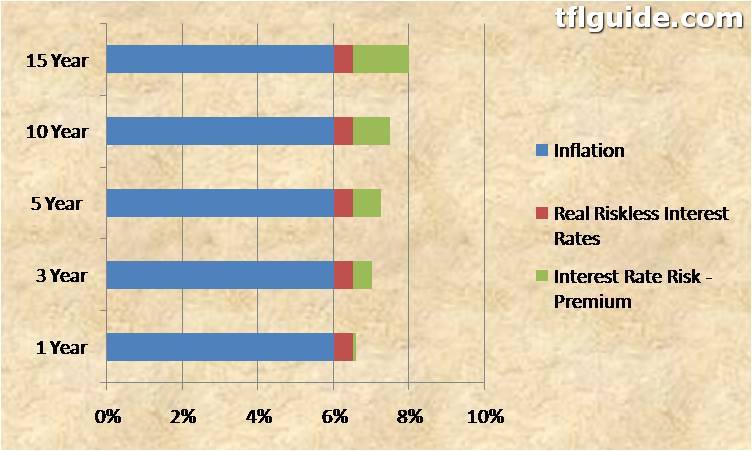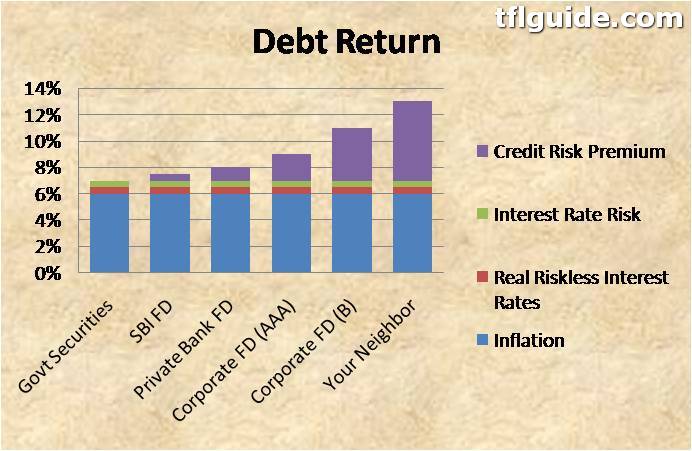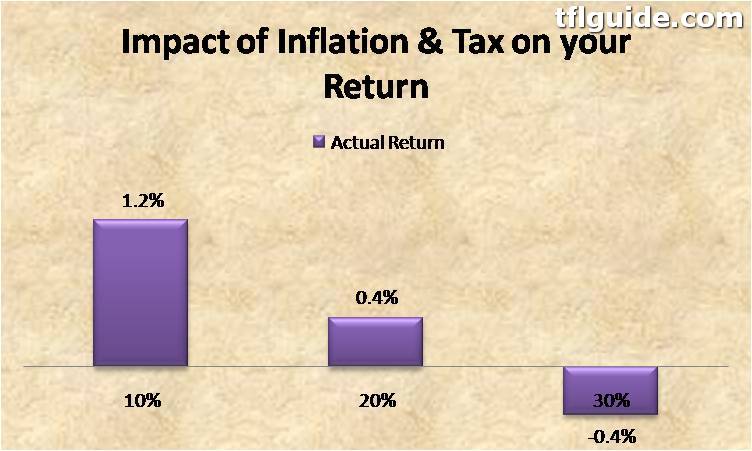These days you keep hearing that you are getting negative returns on bank Fixed Deposits & other debt instruments. After reading this article you may feel that it’s a big conspiracy done by government against you so that you never become rich. Sounds shocking? But it’s true and that too across the world. And if we talk about India where our 90% of financial savings are in debt instruments, the problem is even bigger. So first let’s understand why & how you get returns on your debt instruments & later we see why it will always be negative return.
![D123 Why Fixed Deposit & Debt Returns will always be Negative [With Calculation]](https://www.retirewise.in/wp-content/uploads/2011/02/Why-Fixed-Deposit-Debt-Returns-will-always-be-Negative-With-Calculation.jpg) Debt Return
Debt Return
![D123 Why Fixed Deposit & Debt Returns will always be Negative [With Calculation]](https://www.retirewise.in/wp-content/uploads/2011/02/Why-Fixed-Deposit-Debt-Returns-will-always-be-Negative-With-Calculation.jpg)
Let’s start the discussion with the government bonds (security) interest rates. This rate forms the basis of other debt instruments, be it bank deposits, post office scheme, corporate bonds/fds rates. The Government Bond debt return is build up of 3 components:
Inflation: Long term expected inflation is already build in your debt returns. Basically this is the power that money looses over a period of time. In normal circumstances you can call it the dearness that the economy experiences.
Real Riskless interest rate: Some small percentage that you get because you are giving your money to someone for use today. And this someone is the government in this case.
Premium for bearing interest rate risk: Interest rates keep fluctuating and that is risk for your debt investment. There is a negative correlation between debt(bond) investments & interest rates – if interest rates rise your debt instrument will give negative return & vice versa. (This premium increases with time which you can see in next chart)
These things will be clearly visible in long term. But to keep things simple let’s assume that inflation is expected to be 6% in next 3 years, Real Riskless interest rate is .5% & Interest rate risk premium is .5% – so if we total all this we can get return of 6%.

Also Read: Personal Finance Tips
As already mentioned above 3 components will be same for any debt interest rate instrument but 1 more component is added for any instrument other than government bond.
Credit Risk Premium: Credit Risk Means there is risk that Debtor (to whom you are giving money) can default or situations may arise that he cannot pay. So you want some risk premium depending on the risk profile of the debtor. So in case of Government this will be Zero but in case of SBI Bank this can be .5% or 1% in case of private bank & may be 2-3% in case of co-operative bank. (Even bank FDs are not 100% secured – so in case if some bank defaults you are only guaranteed to get Rs 1 Lakh as this portion is insured by RBI)
Let’s understand this by comparing few other instruments.

Must Check- Top 10 Personal Finance Articles
So it is clear from the above chart that Inflation & risk are the biggest component of interest rate. Onemint keeps updated list of Best Fixed Deposit Interest Rates in India.
Now you have understood that how returns are generated in Fixed Income or Debt Instruments. And thing that can be clearly seen from last graph is if x is saying I will pay you 7% & Y is giving 9% it’s nothing but the risk premium. So there is no guarantee that you will get your money back if some corporate FD will give 13-14% return & this has happened lot of time in Indian debt market history. Names like CRB Capital, Modern & recent one Panjon Pharma still haunt people.
Nominal Return Vs Real Return

What is investment? Investment is the amount that we don’t consume & keep aside for some future need – we park this amount to someone who needs it right now & he pays some rent (interest) to use that amount. So take one example you were having Rs 50000 & 2 choices available – first you can purchase ABC right now & second you lend this money @6% now & purchase it next year. But actually ABC prices rise by 10% in this period. So have you made the good decision by landing money? This can’t be clearly said by this example but if you were planning for your retirement & your money have grown less than inflation it would have significantly impacted.
Calculate Real Return
Real return is when inflation is removed from your nominal return or return after impact of inflation.
This is as simple as Real Rate of Return = Nominal Return – Inflation
Actually formula is different & bit scientific but we will use above formula to keep things simple.
So if Nominal Return is 7% & Inflation is 6% your Real Return will be 1% (With actual formula it would have been even less)
Negative Real Rate
But what is happening now is nominal rate is less & inflation is high so Real Rate is negative. Consider SBI Bank FD Giving interest rate of 7.5% & inflation at 8.5% – this means a negative return or negative interest rate of 1%. So inflation is working as a black hole in your pocket.
Now actual conspiracy of government & why your returns will always be negative in debt investments
You have checked impact of inflation on Nominal Rate but have you ever tested impact of TAX on debt returns.
Let’s assume that you got return of 8% on 3 years FD & you are in 30% tax slab – so after tax return will be 5.6% & if we assume an inflation of 6% your returns are negative. Even if you are in 20% slab & other things same, you will be getting just .4% after tax returns.

Hello Hemant Ji
Very Good article sir. But what is the option for the investor for short term to beat Inflation ?
Long term investor can invest in Equity to get better returns or any other subtitute to invest ?
Sir what about to invest in Silver as it already toches Rs 50,000 per/kg ?
Thanks
Hare Krishna
Hi Mukesh,
In short term purpose of investment in easy liquidity & preservation of capital – beating inflation is important but without taking risk. Mutual Fund FMPs can give some benefit but still it is not a clear winner
https://www.retirewise.in/2010/03/fixed-deposit-vs-fixed-maturity-plan.html
As you said in long term investor can invest in equity but my question is do people really understand equity or make any effort to understand it.
https://www.retirewise.in/2010/11/what-is-equity-understand-its-right-meaning-to-reap-the-benifit.html
I am not sure how silver came to your mind.
Hi Mukesh,
This article only clerifies what happens when you try to invest in a single invest class for all your goals.
Fixed Deposit can be considered for short term investment as its highly liquid.Which means your investment decision should be based on your time horizon and not by returns.So equities should be considered only for your long term goals.
where will silver go, i think research analyst can very well answer that.But then do you want to invest just because it is going higher?
Jitendra
Hi Jitu,
Your rightly said “But then do you want to invest just because it is going higher?”
Actually price rice in these assets have great side effects which people will realize at some later date.
Hemant,
You are right.
Also, till few years the psychology of returns was limited to equity investments.But with Gold and Silver gaining volumes, the same is being repeated here.The basic underline of investing in this asset class is now missing.
And there is no answer to this except taking a Financial Planning approach.
Can u plz suggest me some good SIP,i want to invest Rs-1000/- per month for good returns..which company is good for investment for good returns??
Hey Peeya,
Go for HDFC Equity Fund.
Hi Ramana,
You can go for Growth…
Hi Hemant,
ur right regarding negative return of debt instruments. Education is what everyone needs at the moment. Just see the huge difference in the commission agents earn if they sell MF’s they have to ask for fee, if going for ULIP’s on an average they will get 3.5% – 4 % on regular policies & if they sell debt bases insurance policies they can make a killing of range 20% – 40% every year, now who wants to be a loser.
Yes “Education is what everyone needs at the moment” but once people start earning the hardly care about it. 🙁
Dear All,
I have an experience of 12 years in the field of Finance but unforunately till Feb 2009 I didn’t save not a single penny for anything. I’m married and having two kids.
Now I started to invest the money for the future requirements.
If anybody having any suggestion for me they are all most welcome.
Thanks & Regards,
Puri.
Hi Divakar,
I think its not query – its actually a confession or if others are reading a big lesson for them too.
I hope with such type of long experience you must be earning good – go & hire some financial planner who can guide you. And even before investment buy term plan.
Hi Hemant,
I am a little confused about this article. If I invest in a liquid fund or a Gilt fund that returns 9% and choose for the dividend payout or re-investment option, aren’t the dividends tax free in my hand? Of course, DDT will be deducted but I still make 9%.
Hi Mohit,
Liquid Funds last 1-3-5 year return are not more than 6% & that too taxable. Even GILT have not given more than 6% return in last 5 years but yes still we can expect taxable 8-9% in long term from this type of funds. (but how many people understand income/gilt & their relationship with interest rates.)
The situation is challenging due to long period high inflation.If the high inflation is temporary, the long term inflation will average out .Financial planners should consider the longterm inflation factors.In india short term interest rates are influenced primarily by liquidity in the market.The inverted yield curve is a reality and persisting. But in the longterm, the return need to be higher than the inflation since liquity issue will be taken care of by the monetary policy and RBI.We have a perennial problem in the fiscal side and unproductive spending by the Govt creates inflationary momentum in the economy.The real losers are the CASA deposit holders who earn 2-3% return and constitute more than 40% of the banking sector deposits.Financial Planners should advise these depositors to convert it to flexi deposits so that they can earn 3-4% more.But the credit risk premium is the depositors call and is a reflection of his/her risk appetite.
Hi Prakash,
If you see I have assumed everything & for final calculation I have taken interest at 8% & inflation at 6%. (still I have shown a 2% real return & I don’t think there are many periods in last 25-30 years which shows real return more than 2%)
For some other article I did research on interest rate & inflation – in last 30 years average interest rate was 9.35% & inflation well above 7%.
You rightly said people should not dump lot of money in CASA.
Good point/points made but still the attraction towards the FDs and debt instruments will never fade or go away due to the “SAFETY” part attached to it and many think safe money is good rather than taking risks.
Hi Shiva,
I agree with you but safety is illusion.
And there is no medicine for illusion. (some doctor can correct me if i am wrong)
Hi Hemant,
Very Good article!
So do we say that, at present inflation, if any FD’s or Debt returns assuring any thing close to or less than 10% are considered to be negative returns or close to 1% as a “realistic return”……
and btw, do we have any other investments other than MF’s or Shares, where realistic returns can beat inflation, tax, etc……..
Hi Mani,
Only 2 investment beat inflation by good margin – equity & real estate.
TINA ! It’s the same story but in a different context.There Is No Alternative for quite a lot of people.Saving but not saving!
Yes,it’s a racket.
Like we used earlier to say during elections,TINA -There Is No Alternative ,for many people.
As in schools we must make people learn by heart that ” Real Rate of Return is =( FD interest- Inflation- Tax outflow)” which gives a big Minus return.That’ll make people run away from FDs.Sadly,thers’s no other option .
Hi Sriri,
TINA – hmmm 🙂
I agree that Equity pays much better and beats the inflation in long run. But wouldn’t it be prudent to invest the ‘interest’ of your FD in Equity keeping your principle amount risk free ?
Hi Amod,
In 99% case answer is NO.
Equity is best asset class & people have to change their perception towards it.
IIFL NCD is Good ?
If i invest Rs 25000 for 60 Months @ 11.90% P.A having Monthly Cummulative interest.
Thus as per my calculation the maturity Amount is Rs: 45120
Assuming Infaltion would be 8%
the Inflation Adjsuted amount @ 8% is= Rs :30707.92
Interest earned during the tenure will be Rs: 20,120
Thus even if we considering Inflation we are getting 20% return on our investment .
Please correct me if i am wrong.
Hi Samir,
NCD is a OK product but one should be very choosy in it. Right now IIFL is trading at discount.
sir,
my husband work for defence services we have took home loan from LIC of 30 lakhs @10.50 int rate for 20 yrs. which make 27000 approx instalment per mnt his salary is 63000/mnt and age is 30 yrs.
we can give house on rent only after 3 yrs
m house wife. plz guide me. how and where should we invest so tht we could pay back principle amount at the earliest.
Hi Subuhi,
Will suggest you to read this
https://www.retirewise.in/2010/12/financial-planning-for-defense-personnel.html
Most of the people are intersted in the physical money which they utlimately receive at maturity & if it is greater than principal amount they are in the profit. To make them think in terms of Inflation based return their old fixed psychology barrier is to be broken thru education & education all the time….
Hi Khalid,
Superb Thoughts. 🙂
hello hemant,
hope you are fine , I love the artical and would apprecaite if you advice me as to what type of investment should I be looking for my kids , as I will need some extra cash 6 years time from 2012.
please advice as to whom should I be in touch with.
god bless
Hi Hemant,
You articles are really good.I have a query. I need 3 lacs in the year of 2015(Apr) for my bro’s marriage.can you pls tell me what is the mode of savings I should follow
hello
Please advice me as to how can me achieve RUPEES 50 lakhs IN 7 years. what should me do and where do me invest.
am 48 years as of April 2012.
thank you
Hi Anselm,
My Suggestion is first you should set all your goals – read this
https://www.retirewise.in/2012/02/setting-smart-financial-goals.html
Hi Hemanth,
I am a NRI, I am investing now in Fix deposit for 9.25% non taxable. This is the good investment? Or please advise, i must invest in equity,realstate, mutual funds , golds . ? For example: If i have to invest 50 lakhs rupees.
Thanking you
Alok
Hi Alok,
In debt 9.25% non taxable is a very good return but you still should allocate some amount in equity diversified mutual funds to generate better returns on your overall portfolio.
Alok,
If you are in US and a permanent resident, Dont get caught into this non taxable investment statement. You are taxed on global income in US and will end up paying tax on it. Taking dollar depreciation and paying tax on interest you earn, you know where you will end up. Not so good….
Kumar
Correct me if I’m wrong. I have heard abt some inflation adjusted debt instruments in d market. How r they?
Hi Kaushal,
I have not heard of any such instruments in India – in US they have such instruments with name of TIPS.
Hi Hemant,
I have been following your articles for a long time and it is being of immense help to take decisions in my personal financial planning . Thank you.
I am 30 and have been a regular SIP MF investor since last 3 years and few months back i have increased it to 20,000 pm. My earning capacity is 70,000 pm, PF (total around 9000/-) deducted, and my monthly expense currently 25000/=. Is this a good portion of my income to invest in SIP, or I should increase/decrease it (I am looking at a long term investment of 5 – 10 years)?
Next, I have been choosing to put 50,000 in debt in every 3/4 months as a risk free investment. Is this a good practice or there could be any correction in my
perspective?
Your guidance would be really helpful.
Hi Hemant,
First of all, I would like to thank you for coming up with this great website/blog. I really appreciate your sincere effort.
I’m a 30 yrs old professional from Singapore. I recently started investing in MFs in India for potential returns in long run and it will be a great help for me if you clear few of my doubts.
1) Say I start investing in SIP of a reputable MF and expect to continue for 10 yrs and then down the road after 3-4 yrs I found that the MF is not performing well and the amount I invested didn’t increase much. So, what should be the best decision at that point ? Should I stop/withdraw my fund and invest somewhere else?
2) Is it a good option to directly invest 10% of your funds in stocks ? I personally believe that if I invest in fundamentally strong companies (like, Tata, Birla, Reliance, Indian Oil, BP etc.) will give you good returns in long runs. Moreover, now we can access/subscribe good market analysis. I would like to have your experienced views on it.
3) Finally, in recent days I have seen a lot of people are trading in Forex (Especially in Singapore). Is it a good place to make consistent return considering that one gets himself educated in this area ?
Thanks once again,
Supriyo
Hi. i have learnt lot from your articles hemantji. Thanks for your efforts.
This is a good post to understand about the debt concept.
In market there are different types of debt products, short,long term, liquid, fmp,income etc. Can you tell me about all these types and their purpose. why to choose them?
Hi Santhosh,
Check this
https://www.retirewise.in/2011/11/bond-debt-fund-guide.html
If we talk of long term investment. Then i feel ppf can beat inflation plus its risk free and tax free. Please correct if i am wrong.
dear anuj obviously ppf so far is the best debt instrument as it has a tax exemption element at the time of maturity compare to fd’s which is taxable.
Hi Hemant,
I read your article : https://www.retirewise.in/2010/12/financial-planning-for-defense-personnel.html.
can you provide such article for IT professional?
Hi Maulish,
Check this
https://www.retirewise.in/2011/11/finance-for-young-techies.html
Hi, currently i am investing in sip like reliance growth, HDFC top 200, Bluchip, and hdfc gold…
My question whether all funds are good for long term? or should i discontinue with any one of them??????
Hi Kapil,
You can read this for equity funds
https://www.retirewise.in/2013/01/best-mutual-funds-to-invest-in-2013-india-top-schemes.html
As far as gold funds is concerned, ETF is more cost effective way but you need to manage a demat account.
Greetings Hemant.
The articles you publish are really thought provoking. I am a 23 year old engineer working with Ericsson. I would like to pursue higher studies in 2016. Can you Please suggest me some best short term (1<3 Years) Investment options, which will help me after a 2 year period of investing. My goal is to attain financial independence while going back to college after 2 years by efficiently deploying my currect salary at work.
Hi Hemant,
I have seen this “Inflation will undo the interest earned” argument in other blogs also. But I think that this might not apply always. Like everything in life, it depends !! Here is my argument considering one small example.
Let us say that I have 5 Lakh Rs in Cash right now. Say, I am getting 9% interest for FD. So, I will get an interest of 45K in an year. Let us say that I intend to spend this on buying a Car. Now, how is inflation calculated ? It is calculated by considering prices of some 400-500 commodities. If the average price of these 500 commodities increases by 7% in an year then we say that inflation is 7%.
Here is the catch!! Of the 500 commodities considered I might not even be touching 450. Price of the car in general might not increase by 7%. SO, the inflation is 7% but the price of the car has not increased by 7%. So, my losses are not really 7%.
Or let us say that I am living in in a tier 2 city and I am spending 20K every month. Again, the question is will my expenses after an year be 20K + 7% of 20 K?? I guess not. This is simply because I am not buying Most of the things considered for calculation of inflation.
This is not based on any empirical data, this analysis based on my gut instinct. What are your views on this?
I guess FD investment works well for NRI as it is non taxable with ROI between 9%-10% per annum. If invested for long term, it may generate good returns (thanks to quarterly compounding).
Your comments please.
Hi Hemant,
Interesting article. But the main question is where should an investor invest for the debt based asset class for long term goals. PPF seems to be a reasonable option but the problem is it’s not liquid. I’ve been searching for its answer since couple of months, but didn’t find any satisfactory answer. It would be great if you could solve this problem.
-Vishal
You say: “Negative Real Rate – But what is happening now is nominal rate is less & inflation is high so Real Rate is negative. Consider SBI Bank FD Giving interest rate of 7.5% & inflation at 8.5% – this means a negative return or negative interest rate of 1%. So inflation is working as a black hole in your pocket.”
Wouldn’t this always be the case for any nation? Reason being that FDs comprise of Inflation as the major chunk, so even if Inflation is low, your FD interest rates would also drop, again bringin the nominal rate below inflation.
As commented by yogi …since interest on NRE deposits is above 7 percent and not taxable .. Is it not better for Nri to have a part of investments in NRE FD,s
Comments are closed.